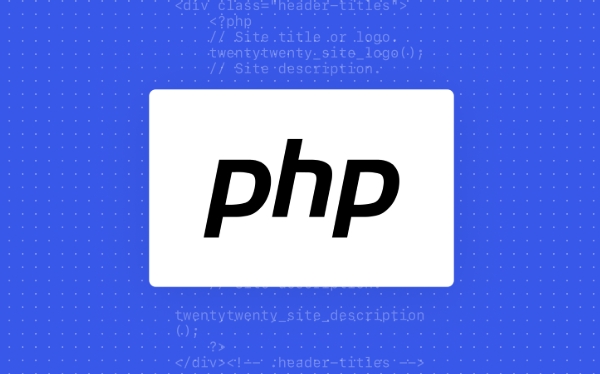How to set and get session variables in PHP?
Jul 12, 2025 am 03:10 AMTo set and get session variables in PHP, you must first always call session_start() at the top of the script to start the session. 1. When setting session variables, use the $_SESSION hyperglobal array to assign values ??to specific keys, such as $_SESSION['username'] = 'john_doe'; It can store strings, numbers, arrays and even objects, but avoid storing too much data to avoid affecting performance. 2. When obtaining session variables, you need to call session_start() first, and then access the $_SESSION array through the key, such as echo $_SESSION['username']; It is recommended to use isset() to check whether the variable exists to avoid errors. 3. Notes include: make sure session_start() is called before any output; make sure the client enables cookies; session_start() is still required before redirection; and do not manually serialize or modify session data unless the purpose of the operation is clearly known. Follow these steps to use the PHP session functionality correctly.

Setting and getting session variables in PHP is straightforward once you understand the basics of how sessions work. The key points are: always start the session with session_start() , use the $_SESSION superglobal to set or retrieve data, and remember that sessions persist across multiple pages as long as they're properly initialized.

Starting the Session
Before you can set or get any session variables, you need to start the session using session_start() . This must be called before any output is sent to the browser — even a blank space or newline will cause it to fail.
-
Do this:

<?php session_start();
Don't do this:
<?php echo "Hello"; session_start(); // This will throw an error
Also, make sure you call session_start() on every page where you want to access session data.

Setting Session Variables
Once the session is started, setting a session variable is as simple as assigning a value to an index in the $_SESSION array.
For example:
<?php session_start(); $_SESSION['username'] = 'john_doe';
You can store all kinds of data — strings, numbers, arrays, even objects (though that's more advanced). Just keep in mind that storing large amounts of data in sessions can affect performance or scalability.
Here's another example:
$_SESSION['user_preferences'] = [
'theme' => 'dark',
'notifications' => true
];Getting Session Variables
To retrieve a session variable, just access the corresponding key from the $_SESSION array after starting the session.
Like this:
<?php session_start(); echo 'Welcome back, ' . $_SESSION['username'];
It's a good idea to check if a session variable exists before trying to use it, especially if it might not have been set yet:
if (isset($_SESSION['username'])) {
echo 'Welcome back, ' . $_SESSION['username'];
} else {
echo 'You are not logged in.';
}A Few Common Gotchas
- Make sure
session_start()is at the very top of your script — no output before it. - Sessions rely on cookies by default, so make sure the client allows cookies.
- If you're redirecting after setting session data, remember that
session_start()still needs to be called before the redirect happens. - Don't serialize or manually manipulate session data unless you know what you're doing — PHP handles it internally.
That's basically it. Sessions are a powerful way to maintain user state across requests, and using them correctly make building things like login systems much easier.
The above is the detailed content of How to set and get session variables in PHP?. For more information, please follow other related articles on the PHP Chinese website!

Hot AI Tools

Undress AI Tool
Undress images for free

Undresser.AI Undress
AI-powered app for creating realistic nude photos

AI Clothes Remover
Online AI tool for removing clothes from photos.

Clothoff.io
AI clothes remover

Video Face Swap
Swap faces in any video effortlessly with our completely free AI face swap tool!

Hot Article

Hot Tools

Notepad++7.3.1
Easy-to-use and free code editor

SublimeText3 Chinese version
Chinese version, very easy to use

Zend Studio 13.0.1
Powerful PHP integrated development environment

Dreamweaver CS6
Visual web development tools

SublimeText3 Mac version
God-level code editing software (SublimeText3)

Hot Topics
 How to combine two php arrays unique values?
Jul 02, 2025 pm 05:18 PM
How to combine two php arrays unique values?
Jul 02, 2025 pm 05:18 PM
To merge two PHP arrays and keep unique values, there are two main methods. 1. For index arrays or only deduplication, use array_merge and array_unique combinations: first merge array_merge($array1,$array2) and then use array_unique() to deduplicate them to finally get a new array containing all unique values; 2. For associative arrays and want to retain key-value pairs in the first array, use the operator: $result=$array1 $array2, which will ensure that the keys in the first array will not be overwritten by the second array. These two methods are applicable to different scenarios, depending on whether the key name is retained or only the focus is on
 How to use php exit function?
Jul 03, 2025 am 02:15 AM
How to use php exit function?
Jul 03, 2025 am 02:15 AM
exit() is a function in PHP that is used to terminate script execution immediately. Common uses include: 1. Terminate the script in advance when an exception is detected, such as the file does not exist or verification fails; 2. Output intermediate results during debugging and stop execution; 3. Call exit() after redirecting in conjunction with header() to prevent subsequent code execution; In addition, exit() can accept string parameters as output content or integers as status code, and its alias is die().
 Applying Semantic Structure with article, section, and aside in HTML
Jul 05, 2025 am 02:03 AM
Applying Semantic Structure with article, section, and aside in HTML
Jul 05, 2025 am 02:03 AM
The rational use of semantic tags in HTML can improve page structure clarity, accessibility and SEO effects. 1. Used for independent content blocks, such as blog posts or comments, it must be self-contained; 2. Used for classification related content, usually including titles, and is suitable for different modules of the page; 3. Used for auxiliary information related to the main content but not core, such as sidebar recommendations or author profiles. In actual development, labels should be combined and other, avoid excessive nesting, keep the structure simple, and verify the rationality of the structure through developer tools.
 How to create an array in php?
Jul 02, 2025 pm 05:01 PM
How to create an array in php?
Jul 02, 2025 pm 05:01 PM
There are two ways to create an array in PHP: use the array() function or use brackets []. 1. Using the array() function is a traditional way, with good compatibility. Define index arrays such as $fruits=array("apple","banana","orange"), and associative arrays such as $user=array("name"=>"John","age"=>25); 2. Using [] is a simpler way to support since PHP5.4, such as $color
 The requested operation requires elevation Windows
Jul 04, 2025 am 02:58 AM
The requested operation requires elevation Windows
Jul 04, 2025 am 02:58 AM
When you encounter the prompt "This operation requires escalation of permissions", it means that you need administrator permissions to continue. Solutions include: 1. Right-click the "Run as Administrator" program or set the shortcut to always run as an administrator; 2. Check whether the current account is an administrator account, if not, switch or request administrator assistance; 3. Use administrator permissions to open a command prompt or PowerShell to execute relevant commands; 4. Bypass the restrictions by obtaining file ownership or modifying the registry when necessary, but such operations need to be cautious and fully understand the risks. Confirm permission identity and try the above methods usually solve the problem.
 php raw post data php
Jul 02, 2025 pm 04:51 PM
php raw post data php
Jul 02, 2025 pm 04:51 PM
The way to process raw POST data in PHP is to use $rawData=file_get_contents('php://input'), which is suitable for receiving JSON, XML, or other custom format data. 1.php://input is a read-only stream, which is only valid in POST requests; 2. Common problems include server configuration or middleware reading input streams, which makes it impossible to obtain data; 3. Application scenarios include receiving front-end fetch requests, third-party service callbacks, and building RESTfulAPIs; 4. The difference from $_POST is that $_POST automatically parses standard form data, while the original data is suitable for non-standard formats and allows manual parsing; 5. Ordinary HTM
 How to handle File Uploads securely in PHP?
Jul 08, 2025 am 02:37 AM
How to handle File Uploads securely in PHP?
Jul 08, 2025 am 02:37 AM
To safely handle PHP file uploads, you need to verify the source and type, control the file name and path, set server restrictions, and process media files twice. 1. Verify the upload source to prevent CSRF through token and detect the real MIME type through finfo_file using whitelist control; 2. Rename the file to a random string and determine the extension to store it in a non-Web directory according to the detection type; 3. PHP configuration limits the upload size and temporary directory Nginx/Apache prohibits access to the upload directory; 4. The GD library resaves the pictures to clear potential malicious data.
 How Do You Pass Variables by Value vs. by Reference in PHP?
Jul 08, 2025 am 02:42 AM
How Do You Pass Variables by Value vs. by Reference in PHP?
Jul 08, 2025 am 02:42 AM
InPHP,variablesarepassedbyvaluebydefault,meaningfunctionsorassignmentsreceiveacopyofthedata,whilepassingbyreferenceallowsmodificationstoaffecttheoriginalvariable.1.Whenpassingbyvalue,changestothecopydonotimpacttheoriginal,asshownwhenassigning$b=$aorp







